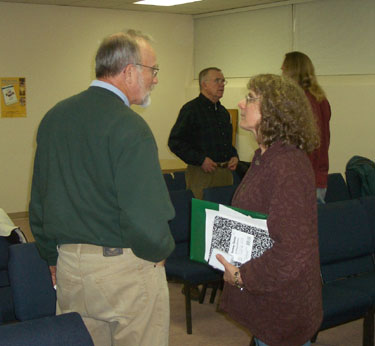
Priscilla Long speaks to the group.

Priscilla answers questions after the meeting.
| Prior meeting summaries and accompanying photos. | |||||
| 2004-2005 meetings Past meeting summaries | |||||
| Sept. 2004 | Oct. 2004 | Nov. 2004 | Dec. 2004 | Jan. 2005 | Feb. 2005 |
| Mar. 2005 | April 2005 | May 2005 | |||
|
Priscilla Long speaks to the group. |
Priscilla answers questions after the meeting. |
Priscilla Long, writer and teacher, spoke about Generating work. Priscilla Long is author of Where the Sun Never Shines: a History of America's Bloody Coal Industry (Paragon House, 1989). Her poetry, fiction, and creative nonfiction appear in Ontario Review, The Southern Review, North Dakota Quarterly, Passages North, Under the Sun, Southern Humanities Review, The Chattahoochee Review, First Intensity, Michigan Quarterly Review, American Letters and Commentary, and elsewhere, and she won The Journal's Creative Nonfiction Prize for 2001. Her awards include the Richard Hugo House Founder's Award, the Seattle Arts Commission, the Los Angeles Arts Commission, and the Mary Roberts Rinehart Fund poetry award. She holds an M.F. A. from the University of Washington, and teaches writing at UW Extension, Field's End, and elsewhere. She serves as Senior Editor of the online encyclopedia of Washington state history, www.historylink.org.
Priscilla has studied highly successful and productive
visual artists and applied their lessons to writers.
Some key elements discussed were:
-The highly creative and productive create more duds
as well as masterpieces because they create a high
volume of work. The lesson for writers is to write
every day, even if only for fifteen minutes. Drop
any self criticism and just work through the good
and bad days. Work generates more work and gives back
to you. Waiting for the masterpiece idea to hit will
limit your production. We can’t wait on inspiration
to work. Success can be “I wrote today”
or “I wrote every day this week.” Keep
the faith and do the work. A recent panel of successful
novelists at a local writer’s conference all
emphasized the same idea – write 1000 words
a day.
-Write from a full resource base by following the
pattern of the great artists who were immersed in
science, philosophy and the world around them. Ideas
are everywhere. Expand on your personal autobiography
by taking elements from your life and expanding them
outward into the world. Follow threads of knowledge
where they lead as material for your work and you
will never run out of subjects.
-Give yourself “form assignments” to take
the pressure off making every piece a masterpiece
For example, one writer wrote a sonnet every morning
so some were “bad” but at the end of a
year he had 365 sonnets and enough good work for a
book. Other ideas are the one sentence story –
of one or two thousand words. Copy the structure of
other work but with your own ideas. Write a story
a week. These are good ways to learn the craft of
writing which you must continue to do to get from
the “pretty good” level of unpublished
work to the “great” of published work.
Keep writing shorter work while working on a longer
work. It keeps us learning as we go along. The exercises
in writing “how to” books are also a good
way to write daily but take these a step further by
creating a finished work from each exercise.
-Write short to get the feeling of finishing something.
We learn by the finishing process. Send out the work
because this is part of the creative process as much
as the writing. Don’t just leave boxes of unfinished
material.
-Keep a list of all your work. The great artists all
had extensive lists of all their work and good record
keeping. Keep three lists: list of publications and
published work; a completed and circulating list;
and a list of work in progress. Move work from the
in-process work to circulating to published. As you
improve skills, you can take the older work and rework
it to improve it to the publishable stage.
-Continue to stay immersed in the past and world around
you. Know what else is being done. Read widely in
your genre especially, not to copy, but to absorb
the lessons.
-Have a work space set up where you give yourself
permission to do the work. “Pattern Language”
is an architectural idea where space is arranged according
to natural human patterns.
-Visual artists use “critique groups”
too by having cronies to discuss work with as well
as peer groups who would visit each others studios
and discuss recent work. This is challenging and stimulating
and works well for writers too.